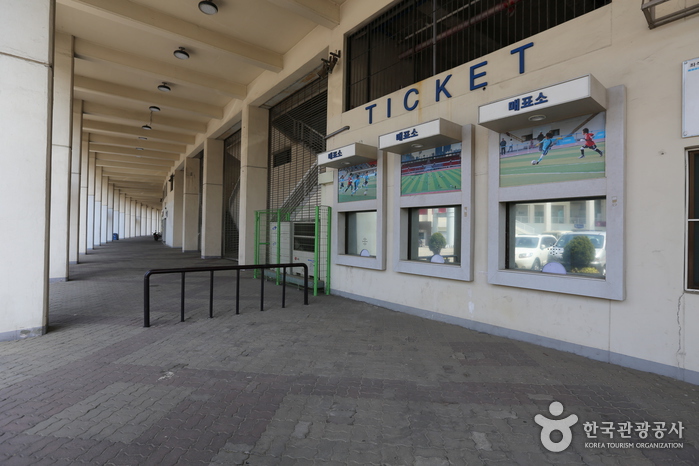Cloche Jewelry - Yongsan Branch [Tax Refund Shop] (클로체 용산점)
4.0Km 2024-04-16
95, Cheongpa-ro 20-gil, Yongsan-gu, Seoul
-
Homeplus - Yeongdeungpo Branch [Tax Refund Shop] (홈플러스 영등포)
4.0Km 2024-04-22
42, Dangsan-ro, Yeongdeungpo-gu, Seoul
-
Olive Young - Homeplus Yeongdeungpo Branch [Tax Refund Shop] (올리브영 홈플러스영등포)
4.0Km 2024-04-23
42, Dangsan-ro, Yeongdeungpo-gu, Seoul
-
CheongKwanJang - Jeungsan Station Branch [Tax Refund Shop] (정관장 증산역)
4.1Km 2024-04-22
#102, 259, Jeungga-ro, Seodaemun-gu, Seoul
-
E-Mart - Susaek Branch [Tax Refund Shop] (이마트 수색)
4.1Km 2024-04-22
217, Susaek-ro, Eunpyeong-gu, Seoul
-
Mokdong Stadium (목동운동장(목동아이스링크,사격장)
4.1Km 2022-09-14
939, Anyangcheon-ro, Yangcheon-gu, Seoul
+82-2-2240-8800
Mokdong Stadium was opened in 1989 with a stadium, a baseball field and an indoor ice rink and added footsal field in 2008 to improve Korea’s sports culture. The soccer field was used as the home field for K-league teams in the past. The ice rink hosts hockey matches and figure skating competitions as well as ice ballet performances. Other facilities include a main square, an indoor shooting range and a gym for residents to enjoy.
LG Best Shop - Mullae Branch [Tax Refund Shop] (엘지베스트샵 문래점)
4.1Km 2024-04-18
37, Dangsan-ro, Yeongdeungpo-gu, Seoul
-
Olive Young - Yeomchang Station Branch [Tax Refund Shop] (올리브영 염창역)
4.1Km 2024-04-22
#102, and #103, 637, Gonghang-daero, Gangseo-gu, Seoul
-
Olive Young - Yongsan Richensia Branch [Tax Refund Shop] (올리브영 용산리첸시아)
4.1Km 2024-04-22
Store #103, #104, #105, #112, 341, Baekbeom-ro, Yongsan-gu, Seoul
-
Seodaemun Prison History Museum (서대문형무소역사관)
4.2Km 2024-12-02
251 Tongil-ro, Seodaemun-gu, Seoul
Seodaemun Prison was built under the Japanese administration to imprison independence movement activists. It first opened on October 21, 1908 under the name Gyeongseong Prison. Eventually, so many activists were imprisoned that the building had to be expanded. At that time, the name changed to Seodaemun Prison on September 3, 1912. Eighty years later, the prison was turned into Seodaemun Independence Park on August 15, 1992 to commemorate the Korean patriots who were tortured in prison, giving their lives for freedom. Of the many buildings, only seven were preserved for their historical significance, among which three prison buildings and the execution site were designated as a Historic Site. In 1998, the park underwent another transformation into today's Seodaemun Prison History Hall to educate the public on the importance of Korea's independence and the sacrifices of those who fought to achieve it.
![Cloche Jewelry - Yongsan Branch [Tax Refund Shop] (클로체 용산점)](http://tong.visitkorea.or.kr/cms/resource/80/2887780_image2_1.jpg)

![CheongKwanJang - Jeungsan Station Branch [Tax Refund Shop] (정관장 증산역)](http://tong.visitkorea.or.kr/cms/resource/44/2889544_image2_1.jpg)
![E-Mart - Susaek Branch [Tax Refund Shop] (이마트 수색)](http://tong.visitkorea.or.kr/cms/resource/14/2888014_image2_1.jpg)

![Olive Young - Yeomchang Station Branch [Tax Refund Shop] (올리브영 염창역)](http://tong.visitkorea.or.kr/cms/resource/93/2880093_image2_1.jpg)
![Olive Young - Yongsan Richensia Branch [Tax Refund Shop] (올리브영 용산리첸시아)](http://tong.visitkorea.or.kr/cms/resource/84/2889184_image2_1.jpg)
 English
English
 한국어
한국어 日本語
日本語 中文(简体)
中文(简体) Deutsch
Deutsch Français
Français Español
Español Русский
Русский